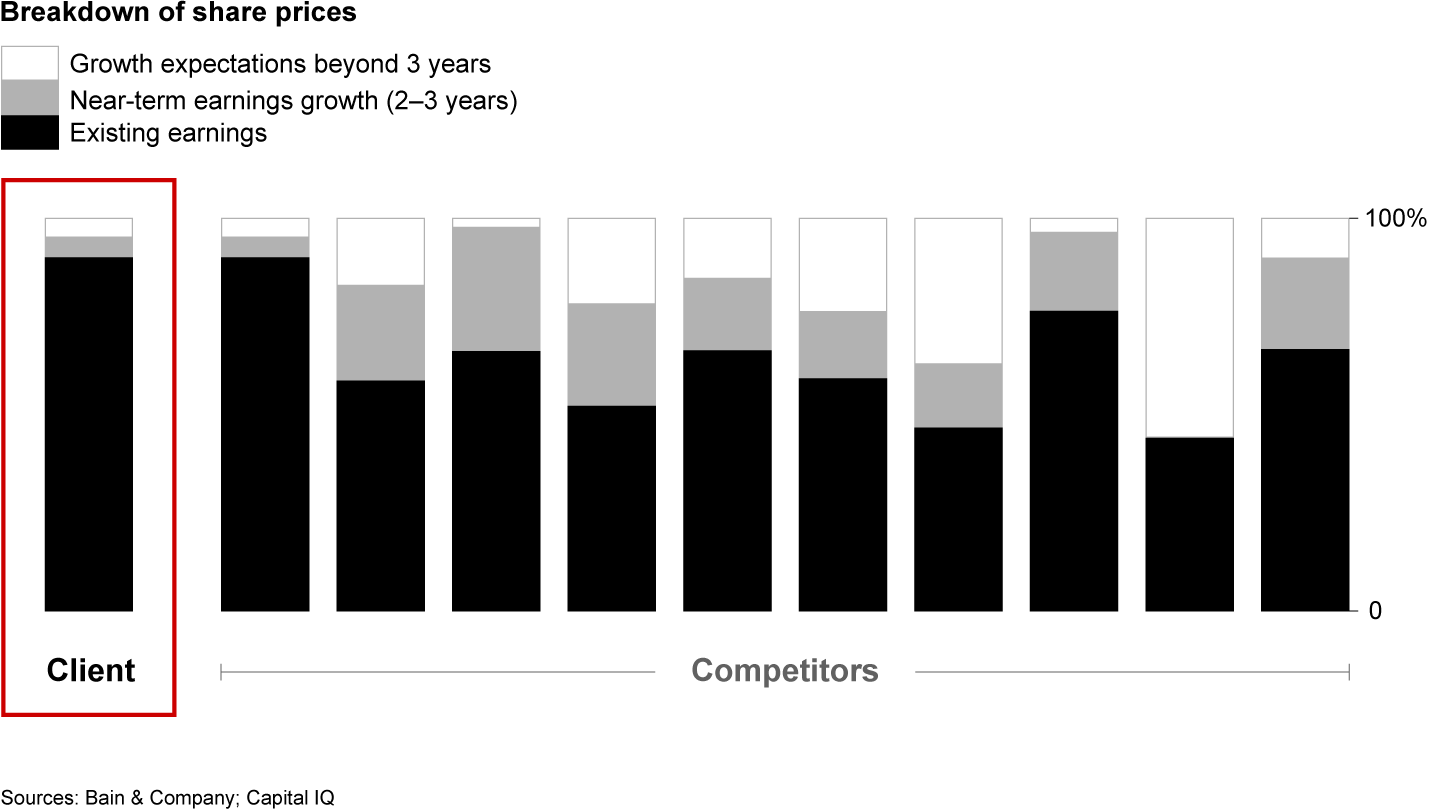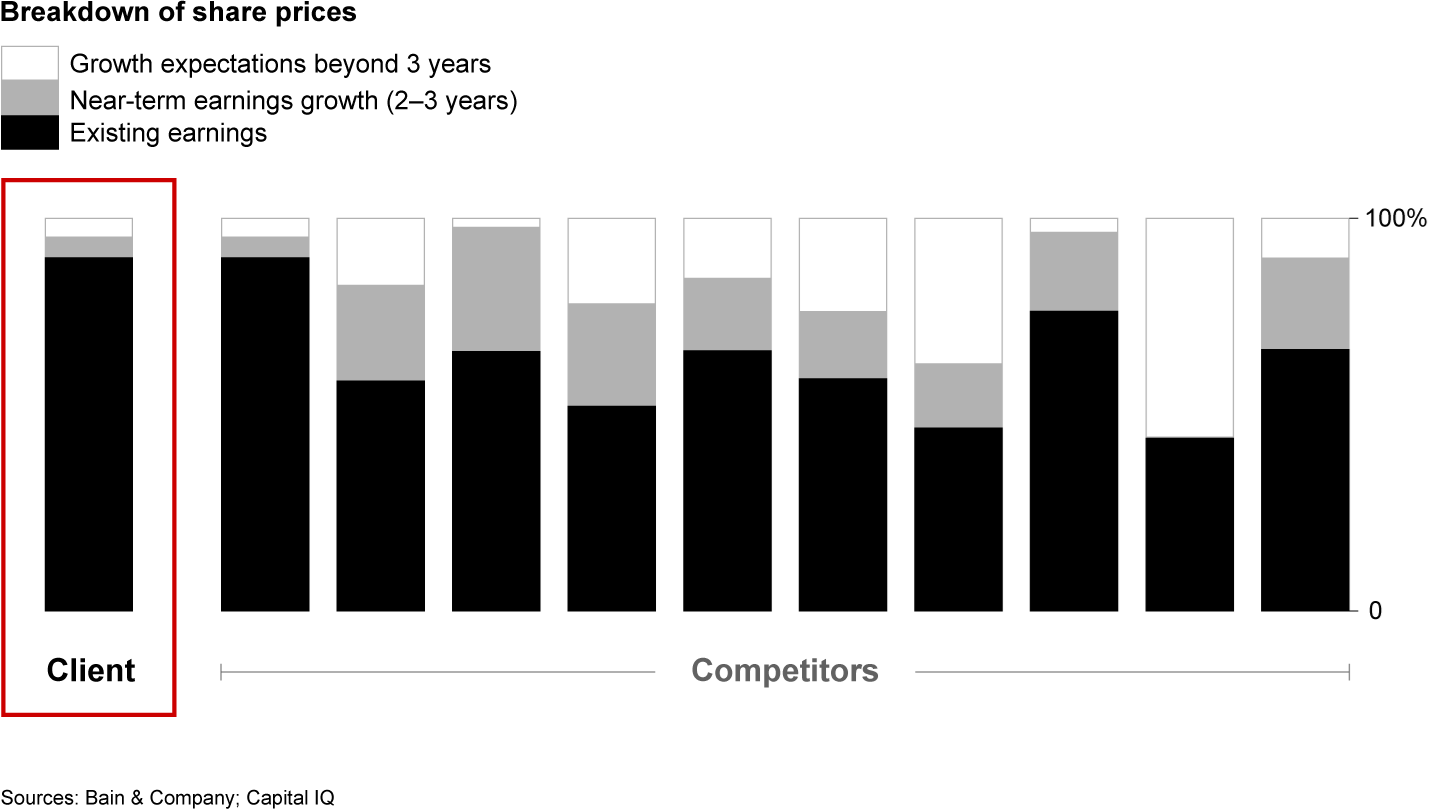Article

What’s keeping CEOs up at night? Among certainly many other things, it’s increasing shareholder value. In an increasingly competitive landscape, they’re wondering:
- Are we attracting the “right” investors? Are major institutional investors investing in our competition but not us?
- Why are competitors getting a higher multiple for expected future growth?
- How can we translate our strategy into a compelling, differentiated equity story?
- Is our roadmap for growth resonating with our target investors—and if not, what will spark confidence in our strategy?
- How do we best apply insights from investor feedback to strategic planning?
With these questions unanswered, CEOs may see a gap between intrinsic and market value—and all too often, the culprit is a passive approach to investor relations. Take the equity story, for example. When companies fail to provide a convincing one that clearly conveys differentiators, they leave valuation potential on the table. In contrast, those companies that successfully close the gap can use high valuations to acquire other firms. Other common pitfalls include not leveraging behavioral segmentation—which is more potent than traditional methods—or keeping a finger on the pulse of investor feedback. In fact, 40% of companies don’t keep track of active shareholders that are not invested in their stock. And most organizations don’t systematically link their investor feedback to their strategy. This leaves critical input—from former, current, and prospective investors alike—trapped in a bottleneck.

Investor Relations: How to Get the Valuation You Deserve
Bain Partners Whit Keuer, Hubert Shen, and Jeff Haxer are joined by Thomas Aebischer, a Fortune 500 CFO, to discuss strategies for successful investor relations.
Companies in reactive mode may not just see a dip in perceived value—they are also more vulnerable to shareholder activism. Our research shows this phenomenon has been steadily increasing over the past two decades, with 30% of survey respondents saying it’s a pressing issue. We can help you fortify your position with a proactive, strategic methodology. Our five-step Investor Relations Strategy approach delivers a clear path to improving IR, and ensures you stay accountable to your goals (see Figure 1). We help you uncover biases about your company and sector, target the investors who can move the stock, and tailor your equity story to those investors who can be persuaded to appreciate and respond to it. Most importantly, we foster collaboration between your IR and strategy teams with integral feedback loops that turn shareholder insights into action.
Get the value you deserve
Define intrinsic value and establish a well-grounded valuation
When it comes to a company’s value, the stock price tells only part of the story. We begin our engagement by getting the full picture, specifically the reasons for a gap between intrinsic and market value. In our experience with clients, we’ve found a few common sources. For one, there’s often a lack of consensus among analysts about business units’ value, typically due to limited transparency of value drivers. Then, we find that analysts can oversimplify the company’s valuation by focusing on units trading at a lower multiple vs. a new growth business.
Our work with one client showed that analysts were not convinced of the company’s growth potential in multiple business units. They overlooked the benefits of a large part of the portfolio by applying a single multiple and then discounted that multiple relative to its peers. Uncovering this back story and supplementing it with feedback from current and prospective investors helped the company craft a new equity story. This stronger narrative sold the benefits of the broader portfolio and made a compelling case for the company’s differentiators.
Understand market and investor biases
Investor feedback is the most direct path to understanding your stock valuation. Whether through regular communication or more structured interviews facilitated by a third party, the insights gained can fuel your strategy—and transform your business.
It’s not uncommon for investor perception to be clouded by incomplete knowledge. For example, when we talked to one client’s shareholders, we learned that they weren’t convinced of a client’s track record in certain business units; this led them to discount the company’s growth potential overall. A “black-gray-white” analysis demonstrates this disconnect (see Figure 2). These investors applied the multiple of the lowest-growth part of the business to the entire portfolio because they simply didn’t have the full picture, including the portfolio’s higher-growth segments. Essentially, this was a breakdown in communication. So, we helped the client improve their messaging to emphasize early results of their growth strategy and the combined breadth of their high-growth business units. This helped them get more credit for what their strategy would deliver—and increase their share of “gray.”
Are you getting credit for your growth plans?


Target the right investors
How well do you know your investors’ priorities and pain points? How well do they know you and your industry? And how attuned are you to target investors? Combined, this intel is central to bolstering IR. Existing methods of investor segmentation (like “growth” vs. “value” investors) are widely available but often fail to address the investors’ underlying behavior and, in tandem, their potential impact.
Our approach to targeting investors is two-pronged. We identify those who can truly move the stock (and understand the minimum trade size required to do this) and home in on those who can be influenced to invest. To identify the most attractive investor segments, we rely on a comprehensive approach that segments the base through three lenses:
- Understanding of the industry: What share of investors’ portfolio includes your industry sector?
- Commitment to individual stocks: Does the investor spread their portfolio across numerous stocks in your industry, or do they invest in a select few?
- Investment horizon: What is the investor’s typical holding period of a given stock?
When we helped segment one client’s investor base, we found that the stock was owned by very few long-term partners—those who truly understood the industry, focused their investment on a few select stocks, and held that stock for a longer period. Recognizing that this group could really move the needle, the client identified a short list of potential targets to pursue.
Craft the equity story and tailor messaging
Information asymmetry is real. Messaging that creates a level playing field for current and potential shareholders mitigates it. At the same time, no two investors are the same. Information needs will vary. We help develop a consistent equity story, then empower you to emphasize different elements to reach target audiences. A compelling equity story is:
- simple—easy to understand and based on a strategy organized by key themes;
- tangible—achievable within a reasonable time frame and accompanied by proofs of concept;
- authentic—aligned with company’s DNA and unique competitive advantages;
- measurable—supported by qualitative and quantitative metrics, tracked over time; and
- exciting—ambitious, innovative, and conveys a credible path to growth.
A strong story is just the start. This narrative must be repeated consistently—and with conviction. At the same time, investors require proof points for each message, and evidence will resonate differently depending on the audience. We encourage clients to build a credential “library” that allows them to tailor messaging to each investor segment.
Review investor feedback—and iterate
Each interaction with an investor is an opportunity to learn and improve. But our research shows that a systematic approach to soliciting feedback is rare. Just one out of 16 companies has instilled formalized feedback loops between shareholders, investor relations teams, and strategy teams.
For one company facing tumbling profits and a burgeoning identity crisis, shareholder feedback was the first step in a dramatic turnaround. Soliciting candid feedback—and then embedding those insights into strategy—required a mindset shift, from one-way communication to a true feedback loop. For our client, this meant first establishing a collaborative relationship between the company’s senior leadership and trusted investors. To further build rapport, the client asked investors thoughtful questions, took suggestions to heart, and then expressed sincere appreciation for the feedback—all critical steps to garnering investors’ trust. In other words, the company had to stop pitching, start listening, and then repeat this at each critical decision-making juncture. By truly involving investors in the process of renewal, the company saw a 35% increase in its stock price one year into its transformation.
Build the required capabilities: people, processes, and tools
Today’s IR teams face an increasingly complex field of investors, a mounting workload, and often limited resources. More than ever, they must streamline efforts by clearly conveying the company’s tactics and goals and relaying investors’ feedback to strategy teams. They need a finger on the pulse of current investors’ plans, skill at courting new ones, and a commitment to preparing senior executives for interactions with investors.
The nucleus of our five-step process is building the right capabilities to meet your goals and then establishing key performance indicators to measure performance. These indicators can be broad—like total shareholder return relative to peers, and the gap between intrinsic and market value—or more pointed, like the percentage of stock owned by target investors, EBITA, or environmental, social, and governance metrics. We suggest combining financial metrics with rich quantitative data about your actions, like time spent with priority investors and use of keywords in quarterly calls, for example. The process doesn’t end with step five—or the implementation of capabilities; in fact, this model is inherently repeatable, creating opportunities for continuous learning and iteration in service of ongoing value creation.

Sustainability & Responsibility
Showing strong ESG performance consistent with the long-term strategy is top of mind for many IR heads---and expected to remain critical in the future.
The right Investor Relations Strategy flips the traditional investor relations approach on its head—from reactive to proactive, from detached to connected. It ensures you don’t leave intrinsic value on the table. It helps you close that gap to market value and greases the wheels of strategy, creating a virtuous cycle that helps you win on total shareholder return.